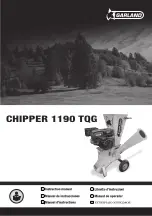
FORM 160.72-O1 (810)
JOHNSON CONTROLS
126
SECTION 4 - GENERAL OPERATING SEQUENCE
The hot gas valve will continue closing during the
ramp-up period at a rate determined by the HGV
RAMP setpoint as long as the HOT GAS CONTROL
output remains below the HGV ramp output signal.
During the ramp-up period, the TEMPERATURE
CONTROL setpoint will track the chilled water out
temperature and its output will be driven to equal the
PRV signal before HSR. The vanes will continue to
open at a rate determined by the PRV RAMP setpoint
as long as the TEMPERATURE CONTROL remains
in MANUAL.
If, during ramp-up, the capacity increases sufficiently
to lower the chilled water outlet temperature to within
the programmed TEMPERATURE CONTROLLER
AUTO MODE DELTA setpoint, the TEMPERATURE
CONTROL is changed to the automatic mode and its
output now changes in response to load changes.
If the load is very low and the control is changed to
automatic before the PRV RAMP CONTROL output
signal has increased to the MIN PRV SIGNAL value
as described above, the higher signal selector HSR will
select the higher of the two inputs. The PRV signal will
decrease until it equals the capacity control signal.
If the chilled water temperature continues to fall, the
TEMPERATURE CONTROL output will decrease
causing the hot gas valve and PRV to move to whatever
positions are required to maintain the chilled water at
setpoint and provide stable compressor operation.
When the ramp-up is completed (PRV signal at 100%)
and/or the TEMPERATURE CONTROL is changed
to automatic, its setpoint will return to whatever
setpoint is stored in the control panel at that time (if
in LOCAL SETPOINT mode), or will change to the
PROGRAMMED remote setpoint (if in REMOTE
SETPOINT mode). The setpoint will change slowly at
a rate determined by the SETPOINT RAMP rate value
to the desired value.
The above tracking and reset tieback controls disable
the TEMPERATURE CONTROL during shutdown and
ramp-up when other logic is in control and provide for
a smooth transition to automatic control as required.
The CAPACITY CONTROLS DIAGRAM Screen will
indicate which signals are currently in control of the
pre-rotation vanes and valves during start-up.
The total ramp times for the PRV and Hot Gas Valves
are also shown. These values will change any time new
ramp times are entered.
override operaTion of TeMperaTure
ConTrol
Maximum power demand limiter Controlling
If this control is used to limit the power demand of
the chiller, its output will drop below the TEMPERA-
TURE CONTROL output. When this happens, SS will
select the lower signal and the vanes will be positioned
by the demand limiting controller.
During this time, the TEMPERATURE CONTROL is put
in the manual mode with its setpoint tracking the actual
chilled water out temperature and its output equal to the
tieback value. The controller's own output as the tieback in-
put, the output of the temperature control holds at the value
it was when the demand limiter took control of the vanes.
If the chilled water out temperature falls below the de-
sired setpoint of the temperature control it is switched
back to the automatic mode, its output will begin to
drop below the demand limiter signal to close the vanes
and maintain the water at setpoint.
If the load increases, the temperature control's output
will increase to open the vanes. If the demand limiter
is still in control, the vanes will only open until SS se-
lects the lower demand limiting signal. If the load in-
creases and the demand limiter is preventing the vanes
from opening, the chilled water out temperature will
increase above the desired setpoint, and the control
will return to the manual mode (at 0.5 degrees above
desired setpoint) and operate as described above.
When the demand limiter has not been controlling
for 10 seconds, the TEMPERATURE CONTROL is
set back to the automatic mode and its setpoint ramps
down to the desired setpoint.
evaporator low pressure override Controlling
The control logic detects when LSR is selecting this
control output signal to limit the vane opening and pre-
vent a low evaporator pressure trip.
During this time, the TEMPERATURE CONTROL is
put in the manual mode and operates the same as de-
scribed above, and returns to the automatic mode 10
seconds after the EVAP LOW PRESS OVERRIDE
control is no longer controlling.
The above tracking and tieback controls disable the
TEMPERATURE CONTROL whenever other logic is
in control to prevent its output from winding up due
to the Chilled Water Out Temperature rising above the
setpoint during the override operation.
Содержание YORK OM Titan
Страница 4: ...FORM 160 72 O1 810 JOHNSON CONTROLS 4 This Page Intentionally Left Blank...
Страница 8: ...FORM 160 72 O1 810 JOHNSON CONTROLS 8 SECTION 1 INTRODUCTION This Page Intentionally Left Blank...
Страница 12: ...FORM 160 72 O1 810 JOHNSON CONTROLS 12 SECTION 3 OPTIVIEW CONTROL CENTER This Page Intentionally Left Blank...
Страница 26: ...FORM 160 72 O1 810 JOHNSON CONTROLS 26 Evaporator Screen This Page Intentionally Left Blank...
Страница 52: ...FORM 160 72 O1 810 JOHNSON CONTROLS 52 Setpoints Screen This Page Intentionally Left Blank...
Страница 78: ...FORM 160 72 O1 810 JOHNSON CONTROLS 78 Options Screen This Page Intentionally Left Blank...
Страница 80: ...FORM 160 72 O1 810 JOHNSON CONTROLS 80 Drive Options Screen This Page Intentionally Left Blank...
Страница 96: ...FORM 160 72 O1 810 JOHNSON CONTROLS 96 History Screen This Page Intentionally Left Blank...
Страница 102: ...FORM 160 72 O1 810 JOHNSON CONTROLS 102 Trend Common Slots Screen This Page Intentionally Left Blank...
Страница 104: ...FORM 160 72 O1 810 JOHNSON CONTROLS 104 Custom Screen This Page Intentionally Left Blank...
Страница 118: ...FORM 160 72 O1 810 JOHNSON CONTROLS 118 SECTION 3 OPTIVIEW CONTROL CENTER This Page Intentionally Left Blank...
Страница 136: ...FORM 160 72 O1 810 JOHNSON CONTROLS 136 SECTION 5 SYSTEM COMMISSIONING This Page Intentionally Left Blank...













































